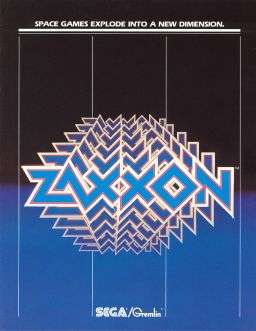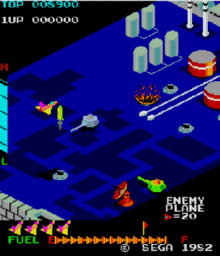Zaxxon
| Zaxxon | |
|---|---|
 North American arcade flyer | |
| Developer(s) | Sega |
| Publisher(s) |
Sega Coleco (ColecoVision) Datasoft (Atari 8-bit) Synapse (C64) |
| Composer(s) |
SG-1000 Katsuhiro Hayashi |
| Platform(s) | Arcade, various |
| Release |
January 1, 1982
|
| Genre(s) | Isometric shooter |
| Mode(s) | Up to 2 players, alternating turns |
| Cabinet | Upright and cocktail |
| Arcade system | Sega Zaxxon hardware |
| CPU | Z80 (@ 3.04125 MHz) |
| Sound | Samples |
| Display |
Raster, 224 × 256 pixels (Vertical), 256 out of 512 colors |

Zaxxon (ザクソン) is a 1982 isometric shooter arcade game, developed and released by Sega, in which the player pilots a ship through heavily defended space fortresses. Some sources[13][14][15] claim that Japanese electronics company Ikegami Tsushinki also worked on the development of the game.
Zaxxon was the first game to employ axonometric projection, which lent its name to the game (AXXON from AXONometric projection). The type of axonometric projection is isometric projection: this effect simulated three dimensions from a third-person viewpoint. It was also the first arcade game to be advertised on television,[16] with a commercial produced by Paramount Pictures for $150,000.[17]
The world record on Zaxxon is 4,680,740 points scored by Vernon Kalanikaus of Lā'ie, Hawai'i, on March 15, 1982, according to the Twin Galaxies Intergalactic Scoreboard.[18]
Gameplay
The object of the game is to hit as many targets as possible without being shot down or running out of fuel—which can be replenished, paradoxically, by blowing up fuel drums.[19]
There are two fortresses to fly through, with an outer space segment between them. At the end of the second fortress is a boss in the form of the Zaxxon robot.
The player's ship casts a shadow to indicate its height.[20] An altimeter is also displayed; in space there is nothing for the ship to cast a shadow on.[21] The walls at the entrance and exit of each fortress have openings that the ship must be at the right altitude to pass through. Within each fortress are additional walls that the ship's shadow and altimeter aid in flying over successfully.
Ports
Between 1982 and 1985, Zaxxon was ported to IBM PC compatibles (as a booter), Apple II, Atari 8-bit family, Atari 2600, Atari 5200, MSX, ZX Spectrum, Commodore 64, Dragon 32, ColecoVision, Intellivision, Sega SG-1000, TRS-80 Color Computer and Model I.[22]
The Atari 2600 and Intellivision ports were noticeably different because they used a 3rd-person, behind-the-ship 3D perspective instead of the isometric graphics of the other versions. The ColecoVision version, designed by Coleco staffer Lawrence Schick, was the first home version to use the isometric graphics.
In 1983 Coleco released a table top version of Zaxxon with a double-panel VFD screen.[23] Bandai[24] released 2 Zaxxon handhelds: one VFD table top for the European and Japanese market, and an LCD card game sold worldwide.
Reception
| Reception | ||||||||||||||||
|---|---|---|---|---|---|---|---|---|---|---|---|---|---|---|---|---|
| ||||||||||||||||
| ||||||||||||||||
Video Games in 1983 called the ColecoVision version of Zaxxon a "coup for this new system".[36] Video magazine also praised the ColecoVision version in its "Arcade Alley" column, describing it as "one of the most thrilling games available", and noting in passing that the only "serious criticism" of the arcade original was that "many players felt they needed flying lessons to have even a ghost of a chance of performing well".[37]:26 Softline in 1983 called the Atari 8-bit version "a superb three-dimensional computer game ... Not since Choplifter has a game looked so impressive". The magazine also liked the graphics of the Apple II and TRS-80 versions despite those computers' hardware limitations, and predicted that Zaxxon would be a "long-lived bestseller".[38] In 1984 the magazine's readers named the game the fifth most-popular Apple program, the worst Apple program, and third-worst Atari program of 1983.[39] K-Power rated the Color Computer version with 8 points out of 10. The magazine praised its "excellent three-dimensional graphics", and concluded that "Zaxxon is a game that can't be praised enough".[30]
II Computing listed Zaxxon fourth on its list of top Apple II games as of late 1985, based on sales and market-share data.[40]
Legacy
Future Spy was created by Sega in 1984. This game uses the same hardware as Zaxxon and has very similar gameplay but with a more realistic military theme.[41]
Re-releases
In 2006, Zaxxon games were included as bonuses on the Sega Genesis Collection for Sony's PlayStation 2 and PSP consoles. The original Zaxxon is the game included on the PS2, and Super Zaxxon is the one available on the PSP. Zaxxon was also included as an unlockable arcade game in Sonic's Ultimate Genesis Collection for the Xbox 360 and PlayStation 3.
The arcade version was released on the Wii Virtual Console in Japan on December 15, 2009,[12] the PAL region on March 5, 2010 and North America on April 12, 2010.
Sequels
Zaxxon spawned an arcade sequel: Super Zaxxon. The color scheme is different, the player's ship flies faster (making the game more difficult), and the robot at the end of the second fortress is replaced by a dragon. It did not do as well as the original.
In 1982 Milton Bradley made a Zaxxon board game.[42][43]
In 1987 Zaxxon 3-D was released for the Master System. This console variation made use of its 3-D glasses add-on for extra depth perception. As with the Atari 2600 and Intellivision ports, it was forward-scrolling rather than isometric.
Zaxxon's Motherbase 2000 was released for the Sega 32X in 1995. It is the first Zaxxon game to incorporate polygon graphics. The game bore the Zaxxon brand only in the United States, as the Japanese version was named Parasquad and the European version was named Motherbase. U.S. gaming critics generally remarked that the game was not similar enough to Zaxxon to justify the use of the brand.[44][45]
Zaxxon Escape was released on October 4, 2012 for iOS and Android devices. The game was criticized for having little resemblance to the original.[46]
Clones
A bootleg was released in the arcades in 1982 called Jackson.[47]
Unauthorized adaptations of the game were published for the TI 99/4A (as Arcturus), Amstrad CPC (as Zaxx), BBC Micro (as Fortress) (1984), and the TRS-80 Color Computer (as Zakssund, 1983).[48]
Hostile All Terrain Encounter (H.A.T.E.) is a Zaxxon clone developed by Vortex Software for several 8-bit and 16-bit computers and published by Gremlin Graphics in 1989.
In popular culture
In 2012 Zaxxon was shown at 'The Art of Video Games' exhibition at the Smithsonian.[49]
A home video game console port of Zaxxon was shown in the music video for the New Order track "Blue Monday".
The character Tommy Jarvis, played by Corey Feldman, in Paramount's feature film Friday the 13th: The Final Chapter can be seen playing Zaxxon during his character's introduction. [50]
Zaxxon was a featured plot device of the 1986 independent feature film Hollywood Zap!.
Zaxxon was seen numerous times in a video gamed-themed storyline of the show Remington Steele episode "Steele Waters Run Deep".
The NPR podcast "Pop Culture Happy Hour" holds its hosts to the "Zaxxon Rule," wherein they are forbidden to bring up topics which are unrelatable to the audience, such as events in one's personal life.
In the ABC sitcom Home Improvement, Randy plays Zaxxon at a bowling alley, attempting to set a record.
References
- ↑ "Zaxxon". Arcade History. October 17, 2010. Retrieved 26 September 2011.
- 1 2 Zaxxon (ColecoVision) at AllGame
- 1 2 Zaxxon (Atari 5200) at AllGame
- 1 2 Zaxxon (Intellivision) at AllGame
- ↑ "Atari 400 800 XL XE Zaxxon". Atari Mania.
- 1 2 Zaxxon (Atari VCS) at AllGame
- 1 2 Zaxxon (Apple II) at AllGame
- 1 2 Zaxxon (Commodore 64/128) at AllGame
- ↑ Gamer's High Futabasha Super Mook (in Japanese). Tokyo: Futabasha. 2015. p. 58. ISBN 978-4-5754-5554-0.
- ↑ "ザクソン まとめ [MSX] / ファミ通.com". Famitsu.com. 2014-02-22. Retrieved 2016-03-11.
- ↑ "ザクソン3D (マスターシステム) まとめ [セガ・マークIII] / ファミ通.com". Famitsu.com. 2014-02-22. Retrieved 2016-03-11.
- 1 2 December 2009 releases in Japan
- ↑ Company:Ikegami Tsushinki - Game Developer Research Institute
- ↑ ドンキーコング裁判についてちょこっと考えてみる Archived 2010-03-12 at the Wayback Machine. Thinking a bit about Donkey Kong, accessed 2009-02-01
- ↑ It started from Pong (それは『ポン』から始まった : アーケードTVゲームの成り立ち sore wa pon kara hajimatta: ākēdo terebi gēmu no naritachi), Masumi Akagi (赤木真澄 Akagi Masumi), Amusement Tsūshinsha (アミューズメント通信社 Amyūzumento Tsūshinsha), 2005, ISBN 4-9902512-0-2.
- ↑ Mark J. P. Wolf (2008), The video game explosion: a history from PONG to Playstation and beyond, p. xviii, ABC-CLIO, ISBN 0-313-33868-X
- ↑ Harmetz, Aljean (July 3, 1982). "Movie Themes Come To Video Games". Star-News. Retrieved 28 February 2012.
- ↑ Zaxxon entry from TwinGalaxies.com
- ↑ Zaxxon from the Killer List of Videogames (KLOV)
- ↑ Bernard Perron & Mark J. P. Wolf (2008), Video game theory reader two, p. 158, Taylor & Francis, ISBN 0-415-96282-X
- ↑ Chris Melissinos; Elizabeth Broun (2012). The Art of Video Games: From Pac-Man to Mass Effect. Welcome Books. pp. 28–9. ISBN 159962110X. Retrieved 17 May 2012.
- ↑ InfoWorld Jan. 1983
- ↑ Announcement of Handheld Zaxxon Electronic Games Magazine July 1983
- ↑ Bandai Zaxxon from handheldmuseum.com
- ↑ Zaxxon (Arcade) at AllGame
- ↑ Zaxxon (Atari 400/800/XL/XE) at AllGame
- ↑ "CVG Magazine Issue 044". Archive.org. Retrieved 2016-03-11.
- ↑ "The HotSeat : Review of New Products" (PDF). Digitpress.com. 1982-11-21. Retrieved 2016-03-11.
- ↑ "Spectrum Software Reviews". Home Computing Weekly. No. 52. 6 March 1984. p. 8. Retrieved 11 February 2012.
- 1 2 Lentvorski, Andrew Jr. (February 1984). "Zaxxon". K-Power. p. 59. Retrieved 16 January 2015.
- ↑ "Le site des anciennes revues informatiques". Abandonware-magazines.org. Retrieved 2016-03-11.
- ↑ "Best Science Fiction/Fantasy Coin-Op Game". Electronic Games. Vol. 1 no. 11. January 1983. p. 35. Retrieved 11 February 2012.
- ↑ "Videogame of the Year". Electronic Games. Vol. 2 no. 23. January 1984. p. 67. Retrieved 11 February 2012.
- ↑ "1985 Arkie Awards". Electronic Games. Vol. 3 no. 35. January 1985. pp. 28–9. Retrieved 11 February 2012.
- ↑ "Hall of Fame Winners". Electronic Games. Vol. 3 no. 35. January 1985. pp. 58–59 [58]. Retrieved 11 February 2012.
- ↑ Wiswell, Phil (March 1983). "New Games From Well-Known Names". Video Games. p. 69. Retrieved 26 May 2014.
- ↑ Kunkel, Bill; Katz, Arnie (April 1983). "Arcade Alley: Zaxxon, Turbo, and Two for Apple II". Video. Vol. 7 no. 1. Reese Communications. pp. 26, 28–29. ISSN 0147-8907.
- ↑ Bang, Derrick; Shore, Howard A. (July–August 1983). "Zaxxon". Softline. pp. 22–23. Retrieved 28 July 2014.
- ↑ "The Best and the Rest". St.Game. Mar–Apr 1984. p. 49. Retrieved 28 July 2014.
- ↑ Ciraolo, Michael (Oct–Nov 1985). "Top Software / A List of Favorites". II Computing. p. 51. Retrieved 28 January 2015.
- ↑ Future Spy from the KLOV
- ↑ Zaxxon from the Great Game Database (GGDb)
- ↑ Zaxxon at BoardGameGeek
- ↑ "ProReview: Zaxxon's Motherbase 2000". GamePro. No. 82. IDG. July 1995. p. 46.
- ↑ "Review Crew: Zaxxon's Motherbase 2000". Electronic Gaming Monthly. No. 71. Ziff Davis. June 1995. p. 36.
- ↑ "'Zaxxon Escape' Review - Hardly A Resemblance (Review)". TouchArcade.com. 2013-12-06. Retrieved 2016-03-11.
- ↑ Jackson entry from CAESAR (Catalogue of Arcade Emulation Software - the Absolute Reference)
- ↑ Boyle, L. Curtis. "Zaksund". NitrOS9. Retrieved 28 March 2014.
- ↑ Choney, Suzanne. "80 video games head for Smithsonian art exhibit". NBC News. Retrieved 13 March 2014.
- ↑
External links
- Zaxxon at MobyGames
- Zaxxon at SpectrumComputing.co.uk
- The MS-DOS version of Zaxxon can be played for free in the browser at the Internet Archive
- High Score Rankings for Zaxxon from Twin Galaxies
- Zaxxon for Virtual Console (in Japanese)